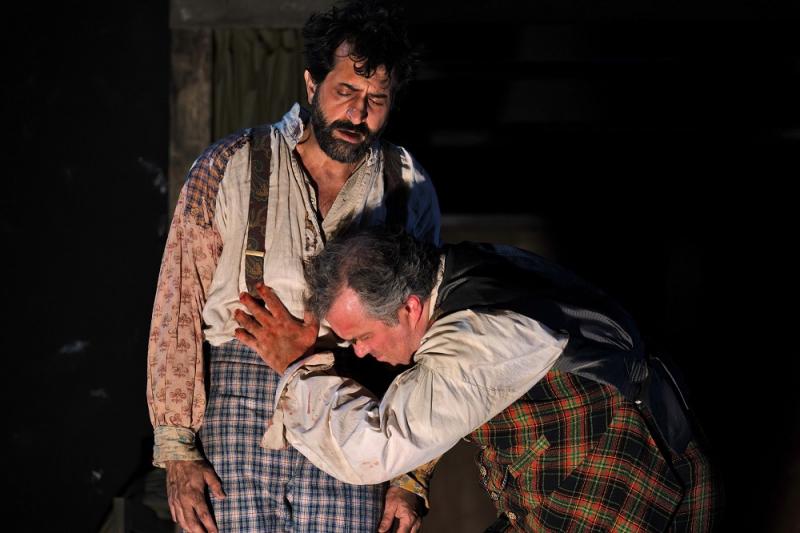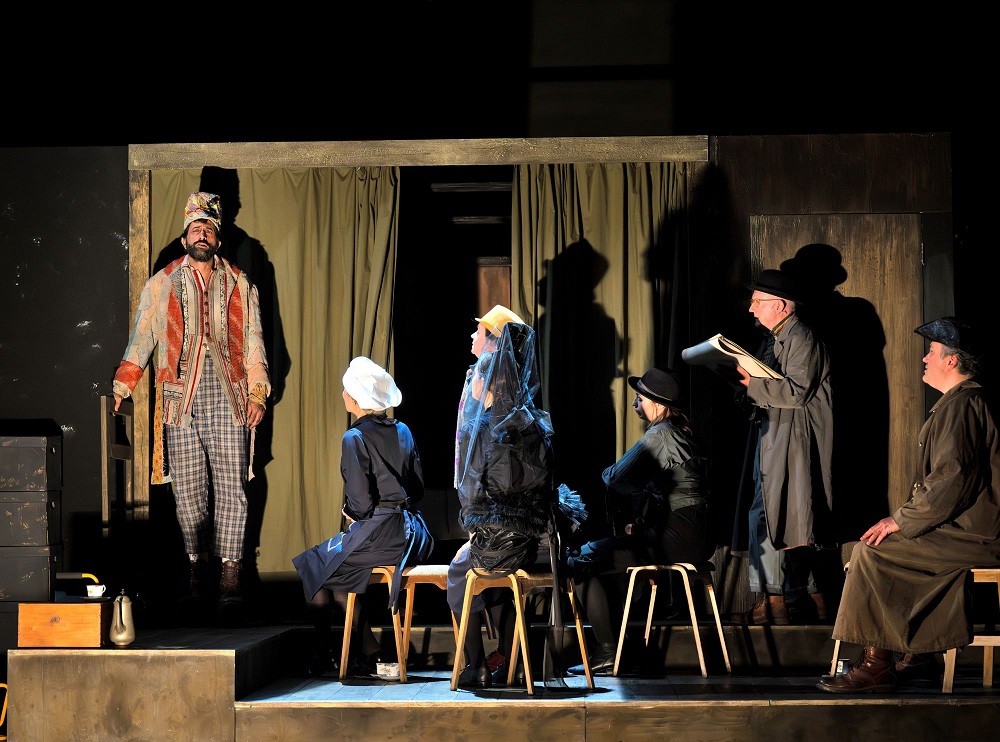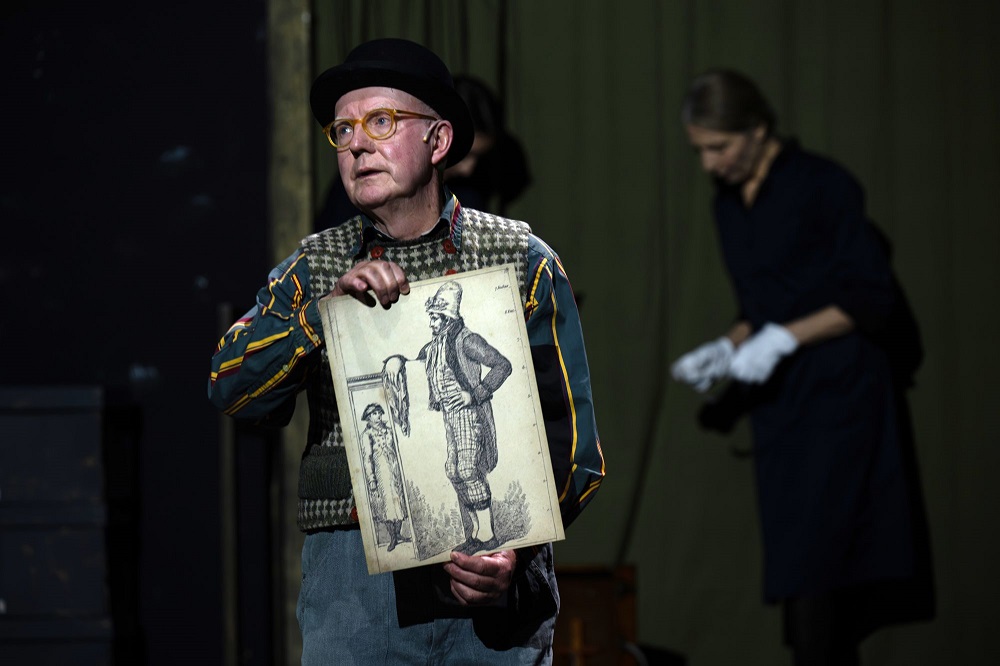Giant, Linbury Theatre review - a vision fully realised | reviews, news & interviews
Giant, Linbury Theatre review - a vision fully realised
Giant, Linbury Theatre review - a vision fully realised
Sarah Angliss serves a haunting meditation on the strange meeting of giant and surgeon

Abandon hope of the human comedy so precisely charted in Hilary Mantel’s related historical fiction The Giant, O’Brien, prepare for a vision of outsized body and soul revealed in sleep, and your patience will be rewarded. Sarah Angliss’s haunting Giant, premiered at last year's Aldeburgh Festival, is perfectly served by her own soundscape, a dedicated team of musicians and Sarah Fahie’s pitch-perfect production.
Its stated intention is to avoid making too much of a God out of Irish giant Charles Byrne and too much of a Satan of Scottish surgeon, scientist and collector John Hunter, who may have intended to serve the living by studying the bones of the dead, but also seemed to take pride in displaying what remained of Byrne after he'd had the corpse stolen – an element of showmanship as sure as that of Rooker (played here by soprano Galina Averina) who keeps the giant locked up and displayed for money. Maybe this Hunter would seem more Satanic if the historical fact of his injecting paupers with syphilis and related diseases to see what happened had been included, as it is so chillingly by Mantel. The stress is on the surgeon's quest to know the secrets of the universe, to open up the mysteries of nature.  Mantel in the afterword to her typically vivid novel suggests Byrne "probably suffered from a pituitary tumour and may have been mentally retarded," quite unlike her own eloquent O'Brien. Angliss's giant (pictured above) sings in visions which include a stylisation of a Gaelic folk song and speaks of infernal disturbances which aren't explained; he's a mouthpiece, not a character, so it's hardly charismatic tenor Karim Sulayman's fault if we view him objectively rather than with pity or much sorrow. Ross Sutherland's libretto is poetic but sometimes falls into the trap of preciousness. Jonathan Gunthorpe's Hunter is shown at first grieving over the autopsy of his young son; the inner conflict is immediately established but he, too, doesn't develop as a personage.
Mantel in the afterword to her typically vivid novel suggests Byrne "probably suffered from a pituitary tumour and may have been mentally retarded," quite unlike her own eloquent O'Brien. Angliss's giant (pictured above) sings in visions which include a stylisation of a Gaelic folk song and speaks of infernal disturbances which aren't explained; he's a mouthpiece, not a character, so it's hardly charismatic tenor Karim Sulayman's fault if we view him objectively rather than with pity or much sorrow. Ross Sutherland's libretto is poetic but sometimes falls into the trap of preciousness. Jonathan Gunthorpe's Hunter is shown at first grieving over the autopsy of his young son; the inner conflict is immediately established but he, too, doesn't develop as a personage.
Though Scottish and Irish accents aren't necessary, some of the spoken dialogue needs work. Hooking us immediately, though, are the live sounds on either side of the action, and later within it, conducted from spooky keyboards by Ben Smith: of the four strings players, Reiko Ichise plucks her viola da gamba to sound for all the world like a specially haunting harp, and in one of three extended instrumental passages which bear the emotional weight of the piece, plays centre-stage, as has Olwen Foulkes on a plaintive recorder presumably sampled to multiply and resound. Stephen Hiscock's work on an array of small bells later becomes a frantic tintinnabulation in collaboration with the soundscape.
Fahie and her set designer Hyemi Shin use minimal props to serve the crepuscular drama – medical diagrams, prints, a bone of two, platforms in conjunction with high-platformed boots to aid the impression of height in Sulayman's Byrne (though he's no phenomenon – maybe that's part of the point). What a distinguished production team this is – in addition to Fahie and Shin, costumes are by Nicky Gillibrand and atmospheric lighting by Adam Silverman.  Byrne's fate – to die at 22 only a year after going on display – keeps a total trance state at bay, and his request to be buried at sea and avoid the voyeurism of being shown as a skeleton is briefly poignant. It isn't made quite clear how Hunter's assistant Howison (Steven Beard) intercepts the cortege and steals the corpse within, but this speaking role offers one of the few dramatic jolts of the evening, where the previously lurking, silent Howison turns into a violent bully to medical students; Beard (pictured above) carries off the monologue brilliantly.
Byrne's fate – to die at 22 only a year after going on display – keeps a total trance state at bay, and his request to be buried at sea and avoid the voyeurism of being shown as a skeleton is briefly poignant. It isn't made quite clear how Hunter's assistant Howison (Steven Beard) intercepts the cortege and steals the corpse within, but this speaking role offers one of the few dramatic jolts of the evening, where the previously lurking, silent Howison turns into a violent bully to medical students; Beard (pictured above) carries off the monologue brilliantly.
I noted before going to see the performance that Byrne's skeleton could be viewed in the Hunterian Museum at the Royal College of Surgeons in Lincoln's Inn Fields, no more than a 10-minute walk from the Royal Opera House. The guilty pleasure is decently denied us now, though; as a programme note tell us, it was removed from display in 2017.
rating
Explore topics
Share this article
The future of Arts Journalism
You can stop theartsdesk.com closing!
We urgently need financing to survive. Our fundraising drive has thus far raised £49,000 but we need to reach £100,000 or we will be forced to close. Please contribute here: https://gofund.me/c3f6033d
And if you can forward this information to anyone who might assist, we’d be grateful.

Subscribe to theartsdesk.com
Thank you for continuing to read our work on theartsdesk.com. For unlimited access to every article in its entirety, including our archive of more than 15,000 pieces, we're asking for £5 per month or £40 per year. We feel it's a very good deal, and hope you do too.
To take a subscription now simply click here.
And if you're looking for that extra gift for a friend or family member, why not treat them to a theartsdesk.com gift subscription?
more Opera
 Buxton International Festival 2025 review - a lavish offering of smaller-scale work
Allison Cook stands out in a fascinating integrated double bill of Bernstein and Poulenc
Buxton International Festival 2025 review - a lavish offering of smaller-scale work
Allison Cook stands out in a fascinating integrated double bill of Bernstein and Poulenc
 Tosca, Clonter Opera review - beauty and integrity in miniature
Happy surprises and a convincing interpretation of Puccini for today
Tosca, Clonter Opera review - beauty and integrity in miniature
Happy surprises and a convincing interpretation of Puccini for today
 Hamlet, Buxton International Festival review - how to re-imagine re-imagined Shakespeare
Music comes first in very 19th century, very Romantic, very French operatic creation
Hamlet, Buxton International Festival review - how to re-imagine re-imagined Shakespeare
Music comes first in very 19th century, very Romantic, very French operatic creation
 Falstaff, Glyndebourne review - knockabout and nostalgia in postwar Windsor
A fat knight to remember, and snappy stagecraft, overcome some tedious waits
Falstaff, Glyndebourne review - knockabout and nostalgia in postwar Windsor
A fat knight to remember, and snappy stagecraft, overcome some tedious waits
 Salome, LSO, Pappano, Barbican review - a partnership in a million
Asmik Grigorian is vocal perfection in league with a great conductor and orchestra
Salome, LSO, Pappano, Barbican review - a partnership in a million
Asmik Grigorian is vocal perfection in league with a great conductor and orchestra
 Semele, Royal Opera review - unholy smoke
Style comes and goes in a justifiably dark treatment of Handelian myth
Semele, Royal Opera review - unholy smoke
Style comes and goes in a justifiably dark treatment of Handelian myth
 Le nozze di Figaro, Glyndebourne review - perceptive humanity in period setting
Mostly glorious cast, sharp ideas, fussy conducting
Le nozze di Figaro, Glyndebourne review - perceptive humanity in period setting
Mostly glorious cast, sharp ideas, fussy conducting
 Fidelio, Garsington Opera review - a battle of sunshine and shadows
Intimacy yields to spectacle as Beethoven's light of freedom triumphs
Fidelio, Garsington Opera review - a battle of sunshine and shadows
Intimacy yields to spectacle as Beethoven's light of freedom triumphs
 Dangerous Matter, RNCM, Manchester review - opera meets science in an 18th century tale
Big doses of history and didaction are injected into 50 minutes of music theatre
Dangerous Matter, RNCM, Manchester review - opera meets science in an 18th century tale
Big doses of history and didaction are injected into 50 minutes of music theatre
 Mazeppa, Grange Park Opera review - a gripping reassessment
Unbalanced drama with a powerful core, uninhibitedly staged
Mazeppa, Grange Park Opera review - a gripping reassessment
Unbalanced drama with a powerful core, uninhibitedly staged
 Saul, Glyndebourne review - playful, visually ravishing descent into darkness
Ten years after it first opened Barrie Kosky's production still packs a hefty punch
Saul, Glyndebourne review - playful, visually ravishing descent into darkness
Ten years after it first opened Barrie Kosky's production still packs a hefty punch
 Così fan tutte, Nevill Holt Festival/Opera North review - re-writing the script
Real feeling turns the tables on stage artifice in Mozart that charms, and moves
Così fan tutte, Nevill Holt Festival/Opera North review - re-writing the script
Real feeling turns the tables on stage artifice in Mozart that charms, and moves

Add comment